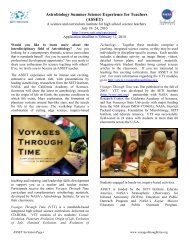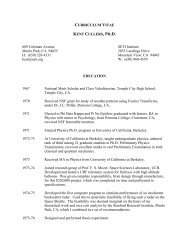SETI Institute Frequently Asked Questions To help you quickly find ...
SETI Institute Frequently Asked Questions To help you quickly find ...
SETI Institute Frequently Asked Questions To help you quickly find ...
- No tags were found...
You also want an ePaper? Increase the reach of your titles
YUMPU automatically turns print PDFs into web optimized ePapers that Google loves.
for life, the structure of the DNA molecule, and the<br />
form of a human being. The message was transmitted<br />
in the direction of the globular star cluster M13, about<br />
25,000 light years away.<br />
Why can't we just send a spacecraft out to look for<br />
other planets and life orbiting other stars<br />
The stars are simply too far away. Our best rockets<br />
travel at about 10 miles per second. Even to reach the<br />
nearest other star system, Alpha Centauri, at about 4.2<br />
light-years’ distance, would take such a rocket 60,000<br />
years. There are about a thousand stars like the Sun<br />
within 100 light-years of us. <strong>To</strong> investigate them all<br />
with spacecraft would take millions of years and vast<br />
amounts of money.<br />
A better scheme is to search for radio waves (which<br />
travel at the speed of light) now, with state-of-the-art<br />
technology, and at a relatively modest cost. The annual<br />
budget of Project Phoenix is $4-5 million dollars,<br />
provided entirely by donors. You can <strong>help</strong>.<br />
Will the senders have any way of knowing that their<br />
signal has been received<br />
No. They wouldn’t be aware that we had received<br />
their message any more than a radio disk jockey<br />
knows that <strong>you</strong>’ve tuned in his show. For the extraterrestrials<br />
to know, we would have to send a message in<br />
reply. The <strong>SETI</strong> <strong>Institute</strong> has no plans for replying.<br />
Under an International <strong>SETI</strong> Post-detection Protocol<br />
now under consideration, the nations of the Earth<br />
would decide together whether and how to reply. It is<br />
worth noting, however, that a complete message exchange<br />
might take decades due to the finite speed of<br />
light.<br />
What happens if <strong>you</strong> do detect a signal<br />
The first thing to do is to confirm that it’s truly extraterrestrial.<br />
Remember, with tens of millions of<br />
channels and antennas that are among the world’s<br />
largest, <strong>SETI</strong> picks up signals frequently. An important<br />
test to verify that a signal is truly extraterrestrial<br />
would be a confirming observation at another radio<br />
telescope.<br />
Once an artificial signal is confirmed as being of<br />
extraterrestrial intelligent origin, the discovery will be<br />
announced as <strong>quickly</strong> and as widely as possible. A<br />
Declaration of Principles Concerning Activities Foldeliberada.<br />
Pese a ello, se han enviado unos cuantos<br />
mensajes con una intención casi simbólica. Uno de<br />
estos mensajes se retransmitió en 1974 desde el<br />
Observatorio de Arecibo, describiendo nuestro<br />
sistema solar, los compuestos importantes para la<br />
vida, la estructura de la molécula de ADN y la forma<br />
de un ser humano. La señal se emitió en dirección a la<br />
acumulación globular M13, a unos 25.000 años luz.<br />
¿Por qué no enviamos simplemente una nave a buscar<br />
otros planetas y vida en otras estrellas<br />
Muy sencillo: están demasiado lejos. Nuestros<br />
mejores cohetes viajan a unos 18 kilómetros por<br />
segundo. Para alcanzar el sistema solar más cercano,<br />
Alpha Centauri, que se halla a 4’2 años luz,<br />
necesitarían unos 60.000 años. Hay algo así como mil<br />
estrellas parecidas al sol en los 100 años luz que nos<br />
rodean; para investigarlas con naves espaciales, se<br />
necesitarían millones de años y enormes cantidades<br />
de dinero.<br />
Es mucho mejor buscar ondas de radio (que viajan a<br />
la velocidad de la luz) con la tecnología actual, a un<br />
coste relativamente bajo. El presupuesto anual del<br />
proyecto <strong>SETI</strong> es de 4 a 5 millones de dólares,<br />
proporcionados totalmente por donantes particulares.<br />
Usted puede ayudar.<br />
Los emisores, ¿tienen alguna forma de saber que su<br />
señal ha sido recibida<br />
No. No se enterarían de que hemos recibido su<br />
mensaje más de lo que un locutor de radio puede<br />
saber si se le está escuchando. Para que los<br />
extraterrestres pudieran saberlo, tendríamos que<br />
enviarles un mensaje de vuelta. El Instituto <strong>SETI</strong> no<br />
tiene planes para contestar en la actualidad. Bajo un<br />
Protocolo de Post-Detección <strong>SETI</strong> Internacional,<br />
actualmente en estudio, serían las naciones de la<br />
Tierra quienes decidiesen juntas si contestar, y cómo<br />
contestar. No hay que olvidar, de todos modos, que<br />
un intercambio de mensajes tardaría décadas, debido<br />
a que la velocidad de la luz es finita.<br />
¿Qué ocurriría si se detectase una señal<br />
Lo primero que hay que hacer es confirmar que sea<br />
realmente extraterrestre. Recuerde, con las decenas de<br />
millones de canales y antenas que hay por todo el<br />
mundo, el <strong>SETI</strong> captura señales frecuentemente. Una<br />
prueba importante para saber si la señal viene de otro<br />
mundo es una observación de confirmación en otro<br />
radiotelescopio.<br />
Una vez que se confirmase que una señal artificial es













